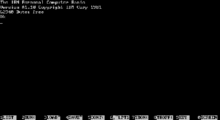IBM BASIC
 |
|
| Developer | Microsoft (for IBM) |
|---|---|
| First appeared | 1981 |
| Influenced | |
| IBM Disk BASIC, IBM BASICA, GW-BASIC | |
 |
|
| Developer | Microsoft (for IBM) |
|---|---|
| First appeared | 1981 |
| Influenced by | |
| IBM Cassette BASIC | |
| Influenced | |
| IBM BASICA, GW-BASIC | |
 |
|
| Developer | Microsoft (for IBM) |
|---|---|
| First appeared | 1981 |
| Platform | IBM Personal Computer |
| OS | PC DOS |
| Influenced by | |
| IBM Cassette BASIC, IBM Disk BASIC | |
| Influenced | |
| GW-BASIC | |
The IBM Personal Computer Basic, commonly shortened to IBM BASIC, is a programming language first released by IBM with the IBM Personal Computer (model 5150) in 1981. IBM released four different versions of the Microsoft BASIC interpreter, licensed from Microsoft for the PC and PCjr. They are known as Cassette BASIC, Disk BASIC, Advanced BASIC (BASICA), and Cartridge BASIC. Versions of Disk BASIC and Advanced BASIC were included with IBM PC DOS up to PC DOS 4. In addition to the features of an ANSI standard BASIC, the IBM versions offered support for the graphics and sound hardware of the IBM PC line. Source code could be typed in with a full screen editor, and very limited facilities were provided for rudimentary program debugging. IBM also released a version of the Microsoft BASIC compiler for the PC, concurrently with the release of PC DOS 1.10 in 1982.
IBM licensed Microsoft BASIC for the PC despite already having its own version for the company's mainframes. Don Estridge said, "Microsoft BASIC had hundreds of thousands of users around the world. How are you going to argue with that?"
IBM Cassette BASIC came in 32 kilobytes (KB) of read-only memory (ROM), separate from the 8 KB BIOS ROM of the original IBM PC, and did not require an operating system to run. Cassette BASIC provided the default user interface if there was no floppy disk drive installed, or if the boot code did not find a bootable floppy disk at power up. The name Cassette BASIC came from its use of cassette tapes rather than floppy disks to store programs and data. Cassette BASIC was built into the ROMs of the original PC and XT, and early models in the PS/2 line. It only supported loading and saving programs to the IBM cassette tape interface, which was unavailable on models after the original Model 5150. The entry-level version of the 5150 came with just 16 KB of random-access memory (RAM), which was sufficient to run Cassette BASIC. However, Cassette BASIC was rarely used because few PCs were sold without a disk drive, and most were sold with PC DOS and sufficient RAM to at least run Disk BASIC—many could run Advanced BASIC as well. There were three versions of Cassette BASIC: C1.00 (found on the early IBM PCs with 16k-64k motherboards), C1.10 (found on all later IBM PCs, XTs, ATs, and PS/2s), and C1.20 (found on the PCjr).
...
Wikipedia
